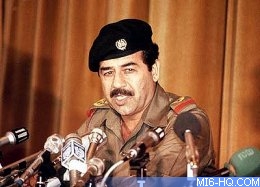 |
| |
MI6 uncovers the shadowy tale of 007 director Terence
Young's work on a Saddam Hussein propaganda film...
|
|
Terence Young - The Dictators Director
21st March 2003
Terence Young's career veered into obscurity after his reign
as the original, and some argue the best, 007 director came to
an end. MI6 now uncovers the shadowy tale of his work for Iraqi
dictator Saddam Hussein in 1980.
|
Young, who helmed "Dr. No", "From Russia
With Love" and "Thunderball" (the largest
inflation adjusted grossing Bond film ever) struggled to
find projects of the scale and intensity of the Bond series
once his reign as 007's director came to an end in 1965.
After a couple of disappointing English films with Omar
Sharif, Young moved to making Italian language films and
slipped into obscurity.
The tale of his work for Saddam Hussein begins in 1979
when Young was approached about a biographical project commissioned
by the Iraqi dictator. Saddam Hussein had come to power
and his campaign of propaganda to strengthen his dictatorship
was in full flow.
Right: The first Bond director - Terence Young
- in the 1960s
|
|
 |
Young was commissioned to edit "The Long Days" (a translated
title from "Ayyam al-tawila"), a mammoth 6 hour biopic
on the life of Saddam - at a time when the West's attitude to
the regime was quite different to what is is today. Saddam's cousin,
Saddam Kamel, who bore an uncanny likeness to the president, played
the role of the dictator.

Above: Saddam Hussein in 1980 |
|
The film was a crucial part of the personal mythology Saddam
constructed around his early life, particularly his involvement
in a 1959 assassination attempt on the life of Abd-al-Karim
Qassim, the brigadier who led the 1958 coup. Saddam was
injured in the gunfight and fled, dressing as a bedouin
and escaping Baghdad on horseback.
According to the film he rode north for four days
towards his home town of Tikrit and almost drowned swimming
across the cold waters of the Tigris to freedom. He later
relied upon his heroic account of the escape to build up
the folklore that fuelled his strongman image.
|
|
"The Long Days" became mandatory viewing for
everyone connected to Saddam's regime. Saddam himself often
spied on the private screenings. Exiled Iraqi's have given
accounts of sudden blackouts at the end of the 6 hour viewing,
after which Saddam suddenly appeared flanked by bodyguards
before delivering a personal speech.
According to reports, Young's work may have extended beyond
that of editing the film. A few people who claim to have
seen the film say that the direction and style of the film
bears a striking resemblance to "Thunderball".
For the actor, Saddam Kamel, a patriotic performance did
little to protect him from the Iraqi dictator's ever-present
temper. For a while Kamel was in favour, and he even married
the president's daughter Rina. But he gradually turned against
Saddam. In 1995 Kamel and his brother, a senior general
in the Iraqi army and a powerful figure in the regime, defected
to Jordan and began to reveal secrets of the Iraqi regime.
Saddam was infuriated. Within a year he enticed the two
back to Iraq and days later had them brutally murdered.
|
|

Above: Young has often been credited as contributing
more to the creation of 007's screen image than Sean Connery. |
Segments from the film have been shown recently on US television
coverage of the Iraq crisis in documentaries charting the life
of Saddam Hussein. MI6 has learned that the PBS programme "Frontline"
is not likely to be repeated in the near future due to the start
of military action against Saddam.
Terence Young died of a heart attack on September 7th 1997.